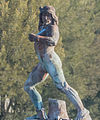Manuel Vilar
Manuel Vilar | |
|---|---|
 | |
| Born | Manuel Vilar i Roca 15 November 1812 |
| Died | 25 November 1860 (aged 48) Mexico City, Mexico |
| Nationality | Spanish |
| Known for | Sculpture |
| Movement | Romanticism |
Manuel Vilar i Roca (15 November 1812, Barcelona - 25 November 1860, Mexico City) was a Spanish sculptor, in the Romantic style.[1]
Biography
His first studies were at the Escola de la Llotja, with Damià Campeny. In 1833, with a grant from the Board of Commerce, he went to Rome where he studied with Antoni Solà and was an assistant in the workshops of Pietro Tenerani. He also received advice from Bertel Thorvaldsen and was influenced by the Nazarene movement.
Upon his return to Spain, he became an instructor at the Escola. He served in that position until 1845, when he and the painter
During his tenure, he insisted on the rigorous study of anatomical models, the sketching of classical examples, practicing on blocks of marble, making plaster castings, and modelling with clay. He worked with religious and historical subjects, as well as the classics, which included themes from the
His early works, in Barcelona, focused on Biblical and mythological subjects; including
He died of pneumonia, aged only forty-eight, and was interred at the iglesia de Jesús Nazareno, where his students created a monument in his memory.[1]
Gallery
-
Jason Stealing the Golden Fleece
-
Monument to Tlahuicole, Tlaxcala
-
Monument to Columbus, Mexico City
-
A bust of Manuel Vilar,
by Felipe Sojo (1833-1869)
References
- ^ a b c d Alberto Espinosa, La Renovación de la Real Academia de San Carlos: Manuel Vilar y Pelegrín Clavé, @ Terranova
- ^ a b "Manuel Vilar i Roca". Gran Enciclopèdia Catalana. Enciclopèdia Catalana. (in Catalan)
Further reading
- Salvador Moreno, El escultor Manuel Vilar, Instituto de Investigaciones Estéticas, Universidad Nacional Autónoma de México, 1969
- José Rogelio Álvarez, "Vilar, Manuel", in: ISBN 978-1-56409-074-4
- "Vilar, Manuel", in: Diccionario Porrúa de historia, biografía y geografía de México, Vol.2, Editorial Porrúa, 1970




